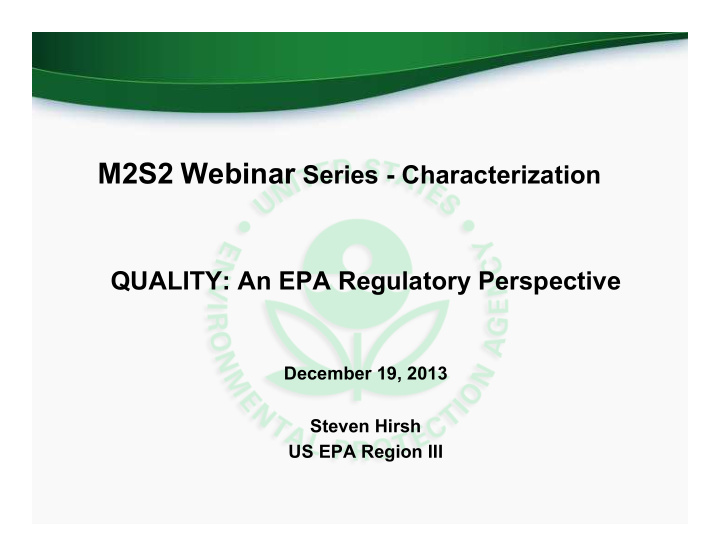



M2S2 Webinar Series - Characterization QUALITY: An EPA Regulatory Perspective December 19, 2013 Steven Hirsh US EPA Region III
Where is EPA involved EPA concerns at munitions response sites Conceptual Site Model Current and Future Receptors Institutional Controls EPA working with others on munitions response quality Intergovernmental Data Quality Task Force (IDQTF) Munitions Response Dialogue (MRD) Munitions and Explosives of Concern Hazard Assessment (MEC-HA)
National Priority List (NPL) Sites, always RCRA Corrective Action, almost always Non-NPL Sites, typically not involved, except: High priority based on risk High priority based on other factors Involvement requested and resource expenditure approved by EPA management
Ensure projects comply with federal law, regulations and guidance for characterization, cleanup and close-out. Provide concurrence with significant project decisions, joint remedy selection at NPL sites and RCRA Corrective Action Five Year Review
EPA fully supports use of ‘new’ tools for collection of high quality geophysical data EPA shares concerns that the universe of executing contractors is small Certification could help build confidence
EPA fully supports classification to improve quality and geophysical target selection EPA has limited capability and experience Heavy reliance on others to perform classification QA/ QC
Formed in 1997 to address issues related to the management of environmental data quality at Federal Facilities Original mission of the IDQTF was “to document an intergovernmental quality system, beginning with the hazardous waste programs” Issued the Uniform Federal Policy for Implementing Environmental Quality Systems (UFP QS) in January 2003 Issued the Federal Quality Systems Roles and Responsibilities Guidance in July 2004 Issued the Uniform Federal Policy for Quality Assurance Project Plans (UFP QAPP) in July 2004 Issue optimized UFP QAPP worksheets in FY2012
Current IDQTF priorities are to help develop and approve cleanup standards in a QAPP format for munitions and small arms range response (including geophysical classification) IDQTF working with USACE and others developing and revising MEC UFP-QAPP templates Capitalize on existing work and not reinvent the wheel Rely on technical experts for detection standards, while participating in an interagency approval and endorsement process for the quality assurance documents
DoD, Federal Land Managers, States and EPA dialogue group Discussing quality issues associated with: Land Use Controls Cleanup Decisions Classification Interim Risk Management Underwater Munitions Constituents Coordination
DoD, Federal Land Managers, States and EPA dialogue group Discussing quality issues associated with: Land Use Controls Cleanup Decisions Classification Interim Risk Management Underwater Munitions Constituents Coordination
DoD/EPA cooperative effort Provides site managers a tool to evaluate cleanup options Typically employed during the Feasibility Study Can be used for Removal Actions Can be used to evaluate Interim Actions
Early stakeholder involvement Realistic future land use assumptions Accurate Conceptual Site Model Use of ‘standard’ formats and templates High quality data collection, evaluation, presentation Interim use control consideration
EPA Federal Facilities Restoration and Reuse Office (FFRRO ) http://www.epa.gov/fedfac/ FFRRO Activities Policy development and implementation: Stakeholder Involvement: Interagency Coordination: FFRRO Program Components Relevant Statutory Authorities Library (see Munitions)
Steve Hirsh USEPA Region III Mail Code 3HS10 1650 Arch Street Philadelphia, PA 19103 hirsh.steven@epa.gov
Recommend
More recommend